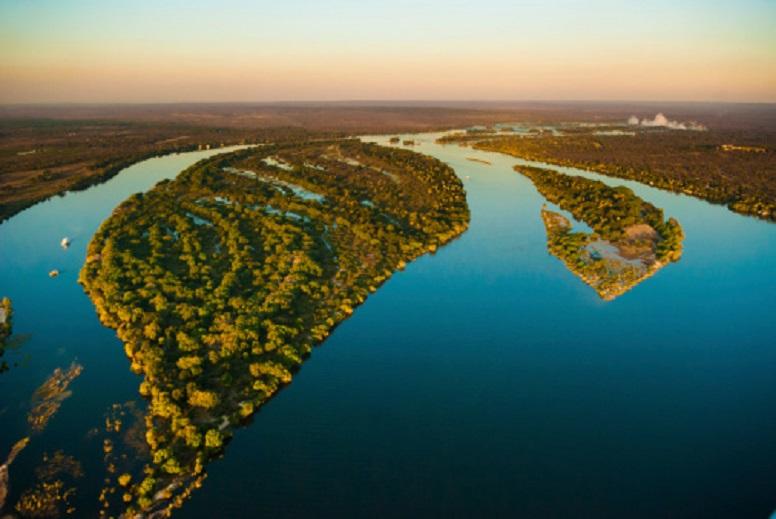Earth is blessed with many rivers, but not all of them could flow to the length of thousands of kilometers. But what are the names of the top five longest rivers in the world?
Water has always been one of the world’s greatest treasures. It occupies more than 70% of the total area of the planet. Pictures taken from space show mighty oceans, sea bowls of different sizes, and majestic gray glaciers. The surface of the land is dotted along and across the river arteries. Tiny small rivers and vast, deep reservoirs, rapid mountain streams, and unhurried winding plain rivers day and night carry their waters to the oceans, feeding all life with moisture for millennia.
From time immemorial, people have settled near the rivers. The water quenched thirst, aided agricultural labors, and served as a natural route for travel and trade. Over the centuries, the situation has not changed much. The longest rivers in the world continue to serve humanity faithfully.
Top 5 longest rivers in the world
1. White Nile (6650 km)
River white Nile is the longest river in the world and probably the most famous. Cradle of an ancient civilization, a giant river artery, ironically located on the driest continent. 6650 km of the Nile crosses the northeastern lands of Africa from south to north, irrigating the sands of the Sahara and supplying water to the Egyptians and the inhabitants of Uganda, Ethiopia, Kenya, and Sudan.
The origin of the Nile is in the region of the Central African lakes. The mouth in the form of a substantial triangular delta is directed to the Mediterranean Sea. The river basin is inhabited by nearly 300 million Africans who cannot imagine their life without the warm Nile water. Human-made canals, robust power plants, active shipping – everything revolves around a river as ancient as the world.
2. Amazon (6400 km)
The length of the Amazon is 6400 km. But it is not this value that is more impressive, but the size of the catchment area. The river basin is 7 million km², which is comparable in size to the Australian mainland. Born from the two South American rivers Ucayali and Marañon, the Amazon simultaneously absorbs the waters of numerous surrounding reservoirs and carries its prey directly to the Atlantic Ocean.
The great river path is laid through many countries: Peru, Brazil, Colombia, Venezuela, Ecuador. On all sides, the Amazon is crowded with lush tropical forests, in the moist thickets of which tapirs, jaguars, and anacondas hide. Blooming lianas and hundreds of other plant species make up the richest collection of the earth’s biosphere.
3. Yangtze (6300 km)
The Yangtze in translation from Chinese sounds like “Long River.” The name is fully justified: it is the longest river in Eurasia (6300 km). Born among the eternal glaciers of the Himalayas, the Yangtze cuts China into the southern and northern halves and penetrates the South China Sea with a mighty delta. As it befits a great river, it is significant for the country’s economic well-being: big cities, home to about a third of the total inhabitants of China, numerous energy facilities, and, finally, natural resources are excellent.
Small Asian crocodiles and sturgeons can be found in the waters of the river. One of the Yangtze mountain stretches, located in the western part of the Yunnan region, is under the patronage of UNESCO.
4. Mississippi (6275km)
The Mississippi is the longest and deepest North American river. It received its name not from the enterprising inhabitants of the United States but the continent’s indigenous population. From the Indian dialect, the word “Mississippi” can be translated as “Great River”. The ancient Indians were not far from the truth. The length of the reservoir is slightly less than 6275 kilometers. The size of the drainage basin is over 3 million km². It sounds incredible, but the Mississippi waters are regularly replenished with numerous large and small rivers from three dozen American states and two Canadian provinces.
The most significant donor in Missouri. The birthplace of the “Great River” is considered a lake called Itasca in northern Minnesota, and the final destination is the Gulf of Mexico. The economic importance of the Mississippi is challenging to overestimate. For the United States, the river serves as a center of intensive shipping,
5. Yenisei (5539 km)
Another Russian miracle is the Yenisei. Starting at the Russian-Mongolian border, the river, bypassing the Siberian lands, rushes like an arrow to the Kara Sea. The length of the Yenisei exceeds 5,500 km. And in the past centuries and today, it is one of the leading shipping routes of the state.
During the Soviet period, the river became a concentration of a large number of hydroelectric power plants serving large industrial factories and plants. The construction has brought severe environmental damage to the region, which still negatively affects the unique Yenisei nature.
